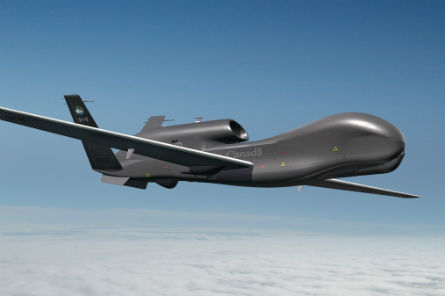Northrop Grumman is pitching a variant of its Block 30 RQ-4B Global Hawk unmanned surveillance aircraft for a potential Canadian requirement to patrol that nation's far northern regions.
Dubbed the Polar Hawk, the aircraft is a modified version of the basic Block 30 airframe, says Northrop's Global Hawk international business development director Dane Marolt. The US defence giant is teaming up with L-3 MAS for its Canadian effort.
To meet Canada's specific requirements, the aircraft's satellite communications system has been modified to cope with the spotty coverage found in the arctic. The aircraft would also have wing deicing and engine anti-icing capability, Marolt says.
The standard US Air Force Block 30 does not have adverse weather capabilities, but the US Navy's MQ-4C Broad Area Maritime Surveillance (BAMS) variant does.
Marolt says that the company isn't offering the BAMS aircraft because it would be much more expensive than the Block 30. Moreover, the naval variant would not be available for about 10 years, he says. But the BAMS' sense and avoid system might be an option for the Polar Hawk "if it is ready in time" and the Canadian government wants it, Marolt says.
 |
|---|
| Northrop Grumman |
Northrop is recommending to the Canadian government that it should retain the Block 30's sensor suite with minimal modifications. That is because country specific modifications are costly and take time to test properly.
Northrop is not offering the airborne signals intelligence payload, which is found on a number of USAF Block 30s. It is not likely that Canada would be interested in that capability, Marolt says. And, it would be expensive.
It would take only a fleet of three aircraft to provide full coverage of Canada's north, Marolt says. During the summer, a single Polar Hawk could fly three to five passes across the length of the Northwest Passage on one sortie, depending on exactly where it is based, he says. During the winter it might be somewhat less.
But the aircraft has enough range and persistence to be able to provide coverage of western Africa from the Canadian east coast, Marolt says. That would give Canada an expeditionary strategic reconnaissance capability.
Marolt says a single Global Hawk can provide coverage equivalent to six medium altitude unmanned aircraft. While a fleet of three aircraft is the minimum, five is probably the optimum number, Northrop says.
Northrop says that the aircraft could cost $30 million to $50 million each, but that figure does not include the ground stations and other support hardware. According to US Air Force budget documents, the cost of each aircraft and its supporting hardware is about $215 million.
Source: Flight International
















